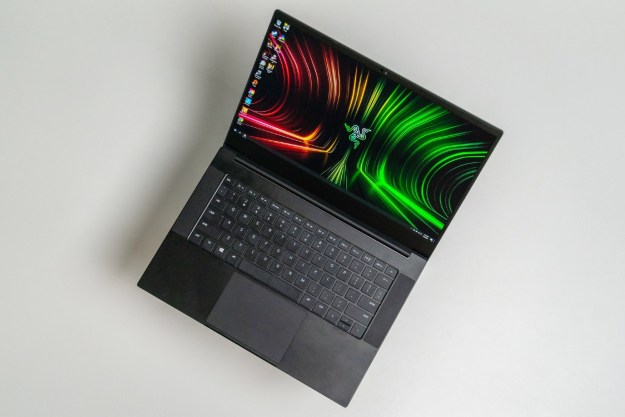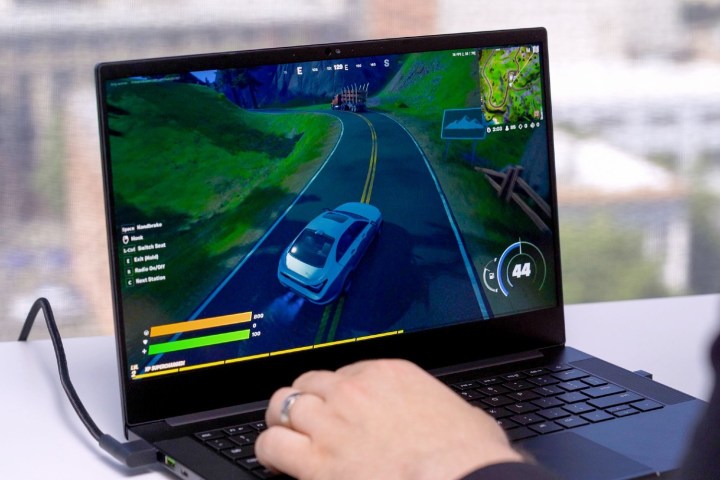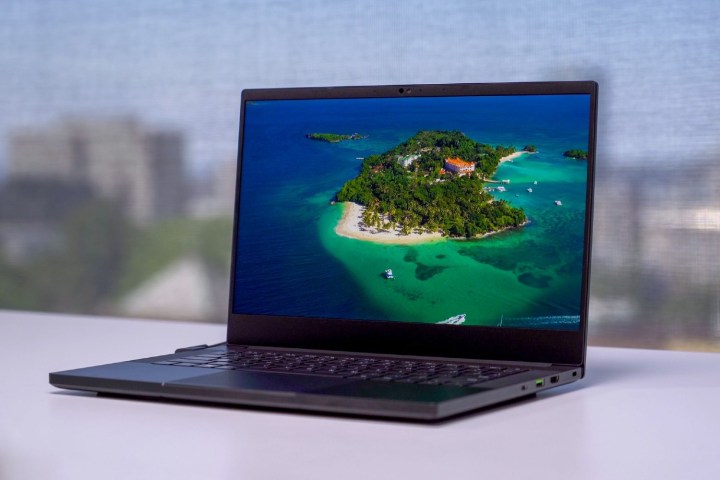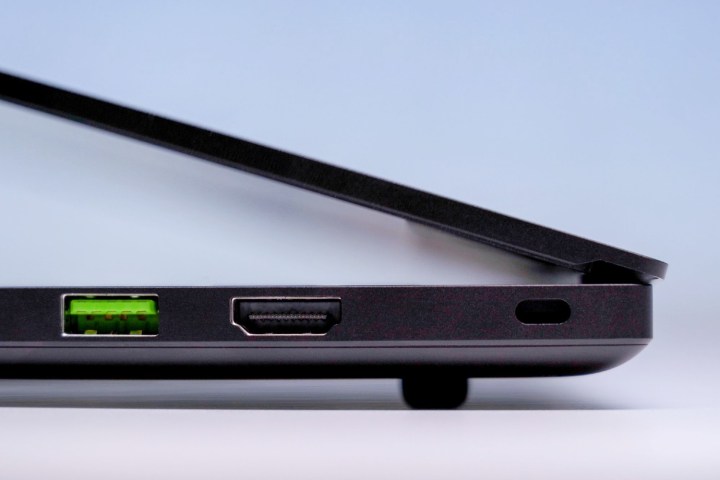
“The Razer Blade 14 steals the crown as the best gaming laptop you can buy right now.”
- Gaming performance is excellent
- Colorful, 1440p display
- Surprisingly small
- Cheaper than Razer Blade 15
- Great battery life
- Warm surface temperatures
- Thick bezels
The Razer Blade 15 was already the world’s smallest gaming laptop. Making an even smaller version with the Razer Blade 14 is, on one hand, an exciting proposition. On the other hand, I had some serious concerns about how Razer could possibly keep these components cool enough.
Throw in an AMD Ryzen 9 5900HX processor and up to an Nvidia RTX 3080 — and you’ve got the potential for a hot mess. Fortunately, the Razer Blade 14 is anything but.
Razer has pulled off the impossible, delivering a fantastic gaming experience in a tiny form factor. With a lower starting price of $1,800, there’s little reason to opt for the Razer Blade 15, as the smaller sibling has stolen the crown from what was the best gaming laptop. A new king has arrived.
Video Review
Design

Despite its smaller size and asking price, it looks nearly identical to the Razer Blade 15. It has the same all-black aluminum exterior, green snake logo on the lid, and little in the way of big vents or gaudy design elements. It’s the same type of minimalist gaming laptop with amazing build quality that the Razer Blade line has always delivered. There’s a reason people call these
The primary change with the Razer Blade 14, of course, is the size of the screen. The 14-inch
The Razer Blade 14 is the thinnest 14-inch
With a smaller screen, however, also comes an overall smaller footprint, which is why I came into this review a little uneasy about this laptop’s ability to keep the components cool enough. The Razer Blade 14 is the thinnest 14-inch
It also makes for a great normal laptop because of its size. It’s just 0.08 inches thicker than the Dell XPS 13 and just 0.03 inches thicker than the MacBook Air. It’s an incredible feat of engineering.

Of course, Razer already makes the Razer Blade Stealth 13 and the Razer Book 13 — if you really just want the Razer stylings without the power. But the Razer Blade 14 feels like the laptop that can do it all without major sacrifices in terms of either portability or design — or performance.
That was the promise ever since this laptop was announced. I was thrilled to find out that the Razer Blade 14 delivers on that promise. For the most part.
As you’ll see in many of the photos, the Razer Blade 14 is an absolute fingerprint magnet. That’s always been true of these black Razer Blades, which makes me wish the Mercury White option was offered for the 14-inch model. The most recent update to the Razer Blade 15 attempted to fix this problem with a fingerprint-resistant coating, but that’s not something the Razer Blade 14 has.
Ports

The Razer Blade 14 has as healthy selection of ports available. On the left side, you’ll find USB-C, USB-A, a headphone jack, and the proprietary Razer charging port. On the right side, you get one more USB-A, one more USB-C, and even
When gaming though, you’ll want to use Razer’s own power charger, which features a nicely braided cable connected to a 230-watt power adapter. It’s large for this size of laptop, but when you’re juicing up power-hungry components like these, it’s unavoidable.
I would have liked to see Razer include a full-size SD card slot as the Blade 15 does, which is hugely convenient for photographers and videographers.
The Razer Blade 14 also features Wi-Fi 6E and Bluetooth 5.2 for the latest wireless connectivity.
Display

The Razer Blade 14 matches what is offered by the 15-inch model in terms of the quality of the screen. It’s a 16:9 1440p IPS display with a 165Hz refresh rate. That’s both a high resolution and high refresh rate, which is the best of both worlds. That’s not a surprise as it’s increasingly becoming the norm in
Image quality is the real surprise. The Razer Blade 14 features fantastic color saturation, hitting 90% of AdobeRGB and 100% of sRGB color spaces, which is basically unheard of for
Do I wish this looked more like the Razer Book 13 with its 16:10 screen and tiny bottom bezel? Absolutely. A taller screen would have allowed for a smaller bottom bezel and more screen real estate, all without needing to shrink the overall footprint. For now, Razer seems happy to stick with 16:9 on its
Performance
I never doubted that the Razer Blade 14 would be a beautiful, well-constructed laptop. Performance and thermals are what had me worried. But as soon as I started using the Razer Blade 14, many of those worries were put to rest.
In some ways, the Razer Blade 14 is actually more powerful than its larger sibling. That’s thanks to the processor inside, which is the 8-core, 16-thread AMD Ryzen 9 5900HX. On raw performance alone, this is the king of

I know Cinebench isn’t the be-all and end-all of processor performance, but it’s mind-blowing that putting this Ryzen chip in the Razer Blade 14 blows the Razer Blade 15 out of the water in this benchmark. It’s a similar result in a video encoding test in Handbrake, where the Razer Blade 15 was 25% slower with its Intel processor.
Add an RTX 30-series
Speaking of graphics, my configuration came with the RTX 3070. It’s still hard to fathom that you can drop an RTX 3080in here too if you want. The 3060 is the base model option, which will still be quite impressive, but in other
When it comes to cooling, Razer managed to pull off the impossible.
But I’ll just say this — Razer managed to pull it off. You get really good gaming performance, even in 1440p, and I never saw GPU temperatures rise over 87 degrees Celsius. Now that’s not exactly what I’d call “cool,” but for a laptop of this size and with this much power, I’m impressed. There’s a massive vapor chamber in here that covers up just about all of the internals, and it’s supposedly even larger than in the 15-inch model.
There are some new fans inside, too, each with 88 0.1mm fan blades. Of course, the huge vapor chamber means you can’t swap out the
Gaming performance

How good is the gaming? Well, most games I tested hit at least 60 frames per second (fps) at 1440p max settings, including Fortnite, Battlefield V, and Civilization VI. Battlefield V performance was particularly noteworthy at 78 fps, which even beats out the much chunkier Lenovo Legion 5 Pro, which is a thick 16-inch laptop we also tested with the RTX 3070.
On the whole, that Lenovo laptop averages better frame rates, especially in Fortnite, where it was as much as 18% faster. Better airflow in a thicker chassis is always going to mean better temperatures and ultimately better performance — but the Razer Blade 14 isn’t as far behind as you might think. It makes you really wonder why we don’t see higher-end graphics options in
The chart below shows 1080p performance to make an equal comparison to cheaper 1080p
| Laptop | 3DMark Time Spy | 3DMark Fire Strike | Assassin’s Creed Valhalla (1080p Ultra High) | Battlefield V (1080p Ultra) | Fortnite (1080p Epic) | Civilization VI (1080p Ultra) |
| Razer Blade 14 (RTX 3070) | 8605 | 19673 | 60 fps | 96 fps | 96 fps | 84 fps |
| Asus ROG Strix G15 (Radeon RX 6800M) | 10504 | 26800 | 77 fps | 109 fps | 108 fps | 91 fps |
| Lenovo Legion 5 Pro (RTX 3070) | 9175 | 21033 | 61 fps | 73 fps | 101 fps | 101 fps |
| MSI GS66 Stealth (RTX 3080) | 9097 | 19175 | 70 fps | 97 fps | 140 fps | 140 fps |
There were a couple of heavier titles I tested that give the Razer Blade 14 a run for its money. Assassin’s Creed Valhalla and Cyberpunk 2077 both couldn’t quite hit 60 fps in 1440p. They get there in 1080p, though, and Cyberpunk plays well enough if you crank up the DLSS settings.
Now, surface temperatures are another story. The Razer
The Razer Blade 14’s palm rests like to get nice and toasty, which can be uncomfortable.
It can get really hot in certain key spots, such as in the space between the keyboard and the display. But that’s normal. Palm rests, though, are what bothered me most and made it stand out more from other
Even while not gaming, the Razer Blade 14’s palm rests stay at a warmer temperature than other
Keyboard and touchpad

Everything else is just as you’d expect it on a Razer laptop. The keyboard and touchpad are both great, and the per-key RGB backlighting is as customizable as it gets with an insane 15 levels of brightness control. It sounds excessive, but compared to the three or four levels that many
Razer even throws in some nice touches like the Windows Hello IR camera above the screen and some decent speakers. They’re upward-firing and are THX-certified, which basically just means THX helped test them to make sure they don’t do things like distort at high volume. The result is a decent set of speakers for watching videos or listening to music. Unfortunately, the fan noise will get in the way of you appreciating the speakers while gaming.
Battery life
Razer promises 12 hours of battery life with the Blade 14. That’s unheard of in a laptop with a beefy RTX 3070 or 3080 inside, but the Razer Blade gets surprisingly close. It landed 11 hours and 20 minutes in our local video playback test, which is almost three hours longer than the Razer Blade 15. It’s a similar comparison in our light web-browsing test, where it lasted eight hours and 17 minutes.
The Razer Blade 14 also outlasts the ROG Zephyrus G14 and Predator Triton 300 SE, which were previously the champions in
You’ll only get so much battery life from a laptop with an RTX 3070 inside, but Razer has squeezed more out of the 61.6 watt-hour battery that I thought was possible.
Our take
There are plenty of cheaper
Are there any alternatives?
Other 14-inch
The Razer Blade 15 obviously has a larger screen, but will cost you $500 more for the same configuration.
How long will it last?
A few Razer Blade reliability problems have been well-documented online, including the bulging battery problem, which appears to be the most notorious offender. It’s still not a problem that has been formally addressed by Razer, however.
Potential reliability problems aside, the Razer Blade 14 should last you four or five years before needing a replacement. The vapor chamber makes it hard to do replacements or fixes yourself, but RazerCare offers up to three years of warranty via a thorough (and expensive) upgrade to the standard one-year warranty.
Should you buy it?
Yes. It’s the
Editors' Recommendations
- Best gaming laptop deals: Razer, Alienware, MSI, and more
- The best thin and light gaming laptops 2023
- Lenovo’s new 14-inch gaming laptop beats the ROG G14 in one key way
- Best Prime Day gaming laptop deals: Alienware, Razer, Asus & more
- One of the most ambitious gaming laptops just got even better



